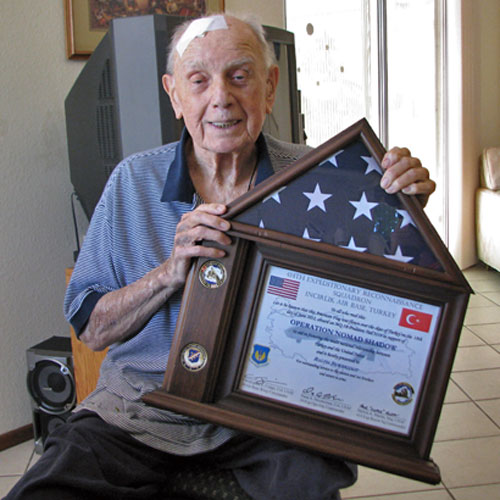
By Ralph Nichols
“Comin’ in on a Wing and a Prayer” was a popular – sometimes all too real – saying in World War II.
But this riveting phrase didn’t come from the 1944 motion picture Wing and a Prayer, which starred Don Ameche and Dana Andrews in the story of an aircraft carrier pilot in the Pacific.
It was coined instead to describe the harrowing return flight of the All American, a B-17 that had had its tail section all but torn off during a bombing mission over North Africa in early 1943.
Ralph Burbridge, who lives in Des Moines, made that flight as bombardier with the crew of the All-American.
In a recent interview with The Waterland Blog, Burbridge recounted that mission – and corrected a dramatic but fictional account, posted online as fact, about the crippled All American’s return to its base.
Assigned to the 97th Bombardment Group, 414th Squadron, U.S. Eighth Air Force, the All American had been named by pilot Kendrick (Kenny) Bragg, who played football for Duke University before the war.
Flying from a base near Biskra, an oasis city in the Sahara Desert in north-central Algeria, the 414th’s missions in early 1943 targeted Mediterranean seaports at Bizerte and Tunis, Tunisia.
That Feb. 1, German Messerschmitts again attempted to fight off approaching American bombers, including the All-American. Closer to the target, these B-17s flew through “very frightening” anti-aircraft fire.
MORE FIGHTER ATTACKS
After dropping their payload and turning back, enemy fighters renewed their pursuit of the American planes before ending the chase as they neared maximum range.
But “long after we had left the target and having sustained more fighter attacks, we saw two more [Messerschmitts] climbing about two miles to our right,” Burbridge recalls.
“They came in to attack us, one of them directly at the nose of the lead ship and one at our plane. I covered one coming at us with the [.30-caliber] front nose gun and Harry (Nuessle, the navigator) covered the other plane with the [.50-caliber] gun on the right side of the nose.”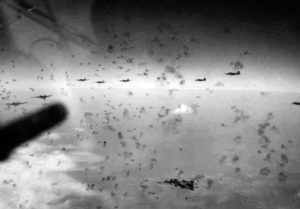
Noting that he and Nuessle “were gunners when not doing our other duties,” Burbridge says “between our own fire and fire from the lead ship, we managed to hit the Jerry going after the lead ship. He was last seen going down smoking off in the distance.”
The other fighter kept coming toward them and “his wings looked as though they were afire from his flaming guns.” When the German pilot was about 300 yards away he began a roll to pull down and away from the All American after his attack.
“But,” Burbridge continues, “about halfway through his roll either my fire or fire from the lead ship must have killed the pilot or disabled the plane. He never completed his intended roll and rapid pass under our ship.”
“WHOOMP!”
“For one horrible instant he was right there – inches in front and above us. He passed over us with a distinctly audible swoosh,” over the roar of the B-17’s Wright Cyclone engines, “followed by a tremendous jar and a ‘whoomp.’”
Bragg quickly informed the crew that there was a hole in the rear and the side of our ship. That Jerry plane had lopped off half of our tail section completely off. The other half and the rudder looked like they would shake loose at any moment.
“Miraculously,” says Burbridge, “none of the crew was hurt, but somewhere in the shuffle the lead ship was lost.” The 10 men aboard his plane put their parachutes on and got ready to jump in case the rest of the tail started to break off.
When other crews saw that it was still airborne, “they put the crippled All American in formation and stayed with us until we were out of enemy territory,” while American fighters provided protection overhead.
Once beyond enemy fighter range, the rest of the planes returned to base ahead of them. Now flying alone, “it seemed like the trip back took 10 years but the base wasn’t really that far. Somehow Kenny nursed the damaged plane and got us home later than everyone else.”
BACK ON THE GROUND
Although the All American landed safely, its tail wheel wouldn’t go down and they skidded the last 100 yards. “I remember our ground crew had given us up so they were really glad to see us,” he says. “Our crew chief, the head mechanic, had tears in his eyes.”
After the plane had stopped, the door was opened and the crew safely climbed out. An ambulance had been waved off as they landed because it wasn’t needed.
Several pictures were taken of the damaged tail section, which finally fell off when ground crew personnel climbed aboard to inspect it.
Lieutenant Charles “Cliff” Cutforth, a crew member aboard the B-17 Flying Flint Gun on that mission, had a camera and took this photo of the crippled All American as it flew above the desolate North African desert:
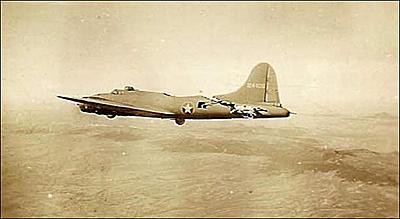
Burbridge calls this fortunate – otherwise “we’d never have made anyone believe the thing would fly with only half the horizontal stabilizer and a very wobbly rudder.” That photo became one of the most famous pictures of World War II.
According to Burbridge, Boeing engineers later said “because we got rammed in the air it was impossible to fly [the All American] but we did. Ken was a good pilot and our co-pilot – Godfrey Murphy – was too. Co-pilots don’t get very much attention but he was a very good pilot.
“Shortly after this, Eddie Cantor, the singer, dedicated the song ‘Comin’ in on a Wing and a Prayer’ to Kenny and our crew.” The song became a number one hit in 1943.
SETTING THE RECORD STRAIGHT
Burbridge notes that one online post presents an inaccurate retelling of this mission and the flight of the All American back to its base in North Africa – not back to England, as claimed – after being hit by the German fighter; a misconception he corrected in this interview.
That account says “we flew down to Africa, bombed the Germans, and then flew back to England.” But, he continues, such a mission was beyond the range of B-17s. “I want to make it clear. Flying from England to Africa is a long trip.”
In addition, it suggests that the All American was struck by the fighter while approaching the target, yet still managed to drop its bombs before limping all the way back, eventually flying just above the water of the English Channel.
But even if B-17s had had the range to fly a mission of this distance and return, the extreme structural damage to the tail section of the All-American would have forced it down long before reaching England.
And flying back over the English Channel would have required the bomber to take a very long, gas-consuming route beyond the coast of Portugal – or to go over German-occupied France at low altitude, where being shot down would have been a virtual certainty.
FIRST MISSION OVER EUROPE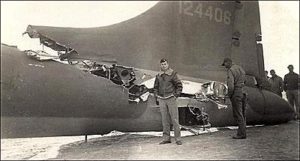
Burbridge grew up in Louisiana, Mo., and enlisted as a cadet in the Army Air Corps at the age of 21 in 1940. He was still a cadet at Montgomery, Ala., on Dec. 7, 1941, when he heard the news that Japanese naval and air forces had attacked by surprise the U.S. Pacific Fleet at Pearl Harbor.
Soon after that, he became a bombardier and was commissioned a second lieutenant. His was one of the earliest classes to graduate and receive their wings after the start of World War II.
After they were commissioned, his crew was stationed at McChord Air Force Base near Tacoma to back up the Navy in the Pacific. After the dramatic American victory over Japan in the Battle of Midway in June 1942, they were sent to an air base in England north of London.
On Aug. 17, 1942, the All American flew its first bombing mission over enemy territory, targeting railroad marshaling yards at Rouen in Occupied France. This was the first “real mission” by American bombers in the European Theater.
“We did severe damage” on this historic mission, led by Paul Tibbets, Burbridge recalls. The All American flew on his right wing.
[Note: Tibbets would quickly earn the reputation as America’s best bomber pilot. It took a very good crew to fly on his wing. Three years later, Tibbets would fly the Enola Gay, a B-29, and drop the first atomic bomb on Hiroshima, Japan.]
ATTACK SURPRISED GERMANS
Twelve U.S. B-17s made that raid on Rouen, accompanied by Royal Air Force Spitfire fighters. “Compare that with later missions, which would fill the sky with hundreds of bombers and their fighter escorts,” Burbridge says.
“All of the planes on this first mission returned safely. The reason for this success was the Germans were not expecting us and Rouen, France, was within the range of the British fighters so they were able to cover us.
“Later in the war when targets were inside Germany, the B-17s [and B-24s] had no cover from the time they approached the targets closely and were over it until they flew back into the fighters’ range. The loss of men and machines was very high.”
FROM ENGLAND TO AFRICA
Not long after the start of Operation Torch in early November 1942, when American and British troops landed in North Africa and began to drive German troops from that continent, the 414th was moved to the African Theater.
Because of the great distance they had to make this trip in two legs, going south from their base in England to Gibraltar, which belongs to Britain, and then across the Mediterranean Sea to a base in North Africa.
“This was a very risky flight,” Burbridge recalls. “We left our base in South England with the planes stripped down. We flew without guns and took just one change of clothes with us. Everything else had to be shipped.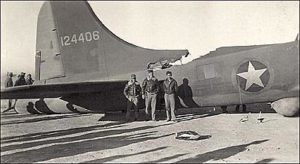
“Boeing had designed two auxiliary fuel tanks that could go in the bomb bay. We flew very low over water to get under German radar. I remember going over the Bay of Biscay and praying that the Germans wouldn’t find us, and they didn’t.”
But Spanish defenders did see them and fired on the B-17s – “very low on gasoline” – as they flew into Gibralter.
The 414th later flew on to Blida in Algeria. Once again, with “with no guns, we were helpless. We were flying so low over the water [of the Mediterranean] to get under German radar that I felt I could go fishing.”
CASABLANCA CONFERENCE
Before their “wing and a prayer” mission, the All American had to fly to Casablanca, Morocco – by then secured under American control – to get new engines to replace those fouled by desert sandstorms.
While his crew was there, a historic meeting between President Franklin Roosevelt and British Prime Minister Winston Churchill took place at Casablanca – the first wartime conference of allied leaders.
[Note: Josef Stalin, leader of the Soviet Union, the other major allied power, did not attend, he said, because of the fierce battle between Russian and German armies at Stalingrad.]
It was at the Casablanca Conference that Roosevelt shocked even Churchill by declaring that the allies would wage war against the axis powers until the “unconditional surrender” of Germany, Italy and Japan.
Burbridge adds that “one side effect of that meeting was that we had some very good food for a change instead of the usual K rations. These usually were spam and biscuits, candy and gum” and cigarettes.
THE WORST MISSION
Despite his crew’s earlier close call on the All American, Burbridge says “our worst combat mission was when we set out to bomb Foggia in Italy” from their new base located near the historic city of Constantine in Northeast Algeria.
Constantine had recently been established as a forward command post for military operations in Tunisia by Gen. Dwight D. Eisenhower, commander in chief of allied forces in North Africa.
“A German fighter came in at 12 o’clock high. He had the sun at his back so we couldn’t see him until the last minute. He was pouring bullets at us. A bullet equivalent to a .30 caliber came past my head and penetrated an ammunitions box filled with shells including incendiaries.
“It spewed forth a thick, acrid smoke, and we could hardly see. However, it did not explode. Harry had the presence of mind and enough time to throw the burning box overboard.”
But that was the least of the damage, he says. Two of the plane’s engines “were shot and smoking, so the co-pilot shut them down. We were flying on the two remaining engines over Italy and thought we would go down for sure.”
The crew strapped on their parachutes and opened the escape hatch door to bail out. But when they looked down and saw they were over Mount Vesuvius, Burbridge said to Harry, “‘I’m not going to jump out here.’ We yelled up to Kenny that we were not jumping.
“The plane kept losing altitude but we made it to the African coast and landed at a place called Bône,” southwest of Italy in Algeria. “We couldn’t make it back to base so we just left the plane there while it was repaired.”
ONE OF THE “LUCKY ONES”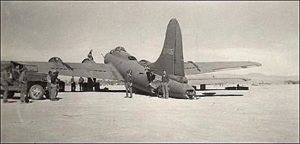
At that time, American bomber crews were required to fly 50 combat missions. Burbridge actually flew 52 – and survived 104 firefights with German fighters.
“I was one of the lucky ones,” Burbridge says. “Our crew lost one man killed and we had two wounded during the course of the war … I believe the prayers of my mother brought me home.”
After his combat duty ended, he was assigned to training command. “I taught ground school for the rest of the war and had to fly every month. I also flew in B-29s.”
The war ended quickly after atomic bombs were dropped on Hiroshima and Nagasaki. “When Japan surrendered, I was delighted, of course. As horrible as it was, I was grateful that the atomic bomb was dropped – and Paul Tibbets never regretted it.”
Burbridge dreamed about German anti-aircraft flak attacks for several years after the war, “but never of the fighter planes coming at us. Many of my buddies also complained of their dreams about flack.”
Looking back, he says “one of the most painful things we had to endure happened when we were firing our machine guns. The hot shell casings would fall into the sheepskin boots we wore and would burn right through our flight suits.
“We couldn’t do anything about getting the hot shells out of our boots because our lives depended on us continuing to fire the guns. We just had to endure the pain.”
And flying missions over the Mediterranean Sea posed a different peril – one that his crew never had to contend with. “The waters were shark invested,” Burbridge notes, “and if we survived a water landing we could provide a nice meal for them.”
With the war over at last, he attended the University of Missouri, earning degrees in business and journalism, then went to work for the Herald-Whig at Quincy, Ill.
Burbridge eventually changed careers, becoming a fundraiser for the Easter Seal Society – the job that brought him to the Seattle area for the first time since he was stationed at McChord AFB early in the war – then worked with federal rehabilitation programs until retiring in Des Moines.

During World War II, when Ralph Burbridge of Des Moines was a bombardier on B-17 Flying Fortresses – including the famed All American, he served in the 414th Bombardment Squadron of the U.S. Eighth Air Force.
Following the war, the 414th was decommissioned. But in November 2011 it was reactivated as the 414th Expeditionary Reconnaissance Squadron. Currently based in Turkey, this Air Force squadron provides intelligence, surveillance and reconnaissance in support of NATO operations.
When the commander of the 414th learned that Burbridge is still alive, after being contacted by his nephew, the squadron hoisted a U.S. flag above their base in Turkey in honor of Burbridge – then sent it to him in a quality case this summer along with a note of appreciation for his service.
Today the 414th still uses its famous patch from World War II – designed after the dramatic “wing and a prayer” return flight of the All American – with a dog on the tail section of the crippled All American saying a prayer!


Ralph Burbridge is a true american hero.
Thank you so much for taking an interest in this story and for allowing Uncle Ralph the opportunity to personally set the record straight on the ‘All American’ ! You’ve done a great job in getting the true story out!
How these stories get embellished, fictionalized and twisted around is beyond comprehension. This particular B-17 story does not need any help to stand on its own!!!
Appreciate you taking the time to research and publish this great article. I’ll be sure to pass this link to the website owners that have the story wrong! Thanks again! Sam
Sam, Please call City Hall at 206-870-6552 so that I can schedule a time for you to come to a city council meeting to tell this incredible story to all our citizens. It will broadcast on channel 21.
My name is John and I am the son of James Gardner who was also a bombardier in the 414th BS. My dad flew in Hell’s Kitchen” and completed 50 missions.
I have a photo taken in 1942, Polebrook, England of my dad and Ralph in a 97th BG gathering. I was wondering if Ralps’s nephew, Sam would be interested. I’d be more than happy to mail it to him.
Thanks for the great story.
THANK YOU Ralph Nichols and Scott Schaefer. When I met with Mr. Burbridge and he told me about the error in the story that had been going around for years, I knew you could and would help him set the record straight. Ralph Burbridge is a fine man and has lived a distinquished life. I will be forever grateful for his sacrifices for my freedom.
Just wanted to say that I have a Shadow Box that was left to me by my Grandfather. He was in the Plane next to this. He had taken the picture and I have it in a shadow box with his medals. My aunt which is his daughter has the issue of LIFE Magazine that has the picture on the cover. There were only a few because LIFE didn’t have rights at the time to put it on the cover at the time.
I wish that there was a way to attach a picture of the shadow box that I have to show with the Picture of “All American” in it.
Thanks for a great story detailing a part of history.
My father’s adoptive family included his uncle, who was the tail gunner on the All American. I only met uncle Sam as an infant, so I have no recollection, but my father had plenty of stories, his dress uniforms, and some copies of the famous photos. Some of the stories I heard include one that, if true, would be amazing.
Uncle Sam, in the aftermath of the collision, realizing the intercom lines had been severed, attempted to crawl through the wreckage to safety. The resulting loss of weight actually caused instability in flight, so he was ordered to return to his post in the tail.
He was wounded in a later mission, and returned to Michigan to start a 100 acre farm. He retired to Arizona, where he passed in the 80s.